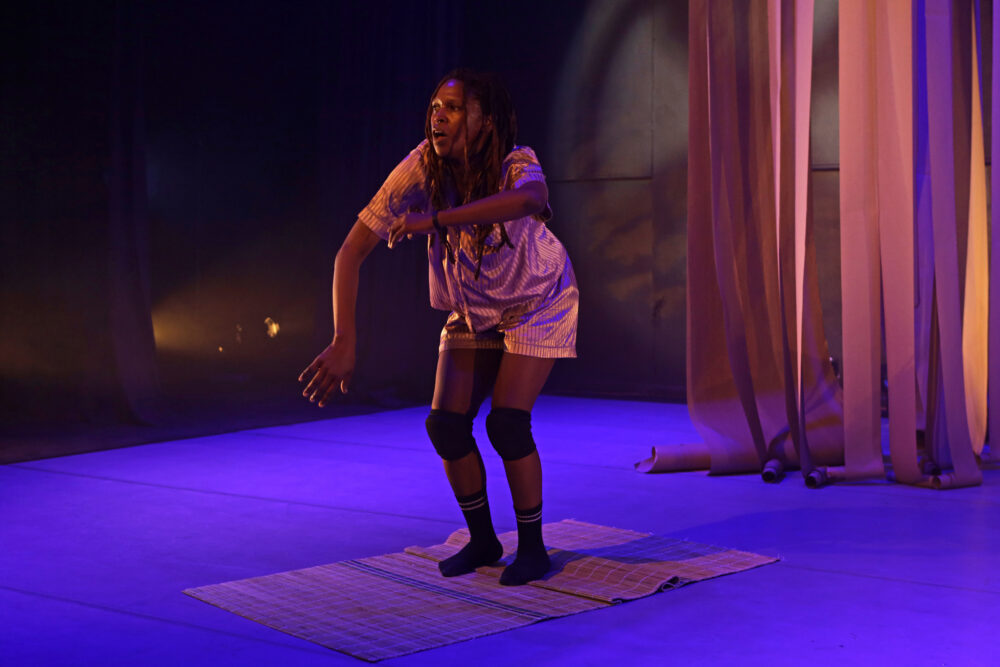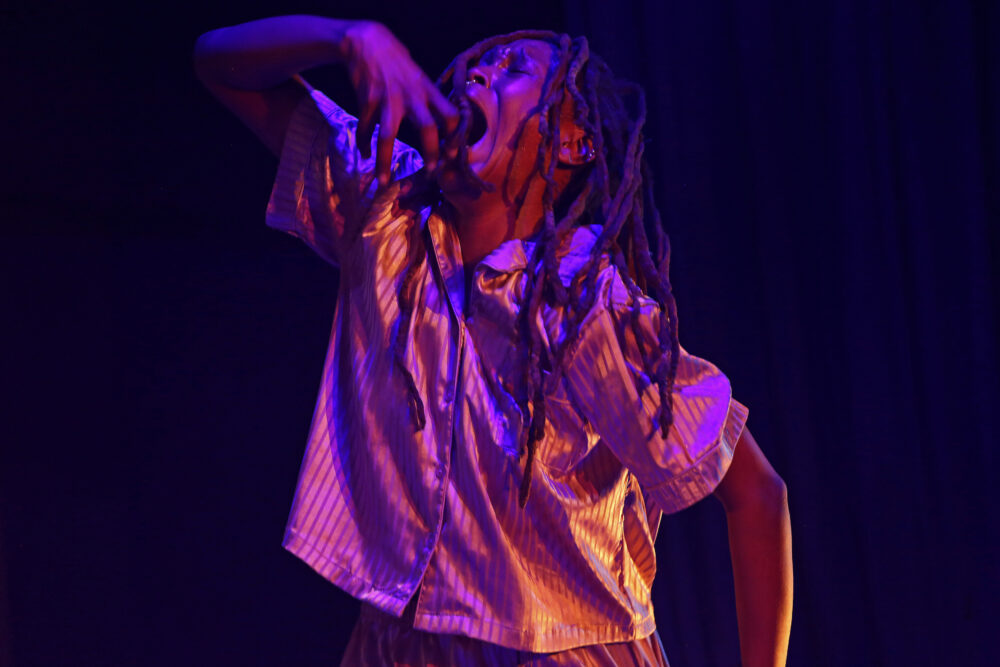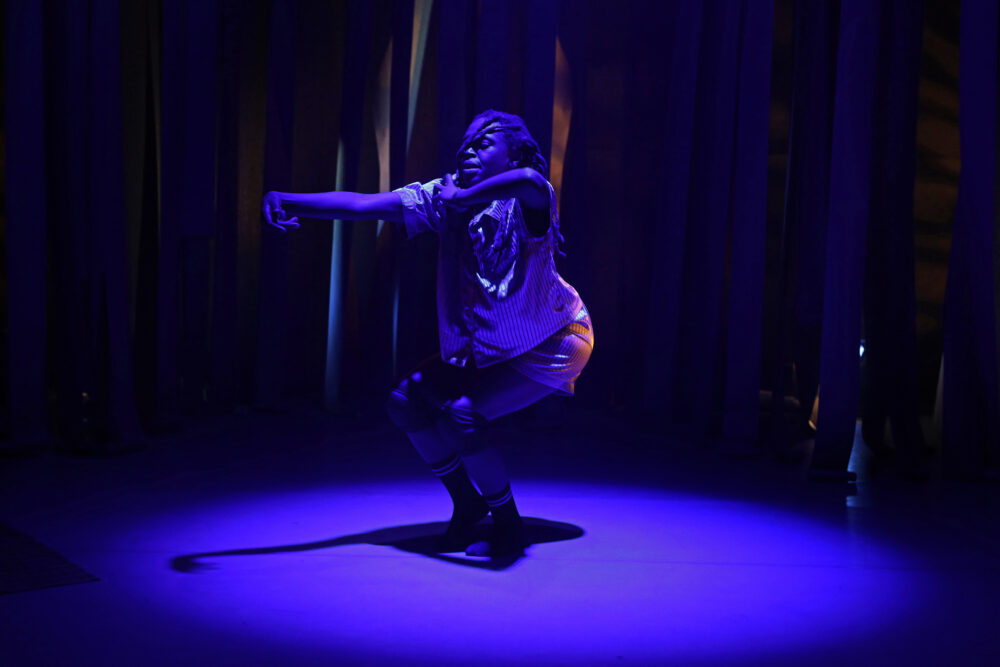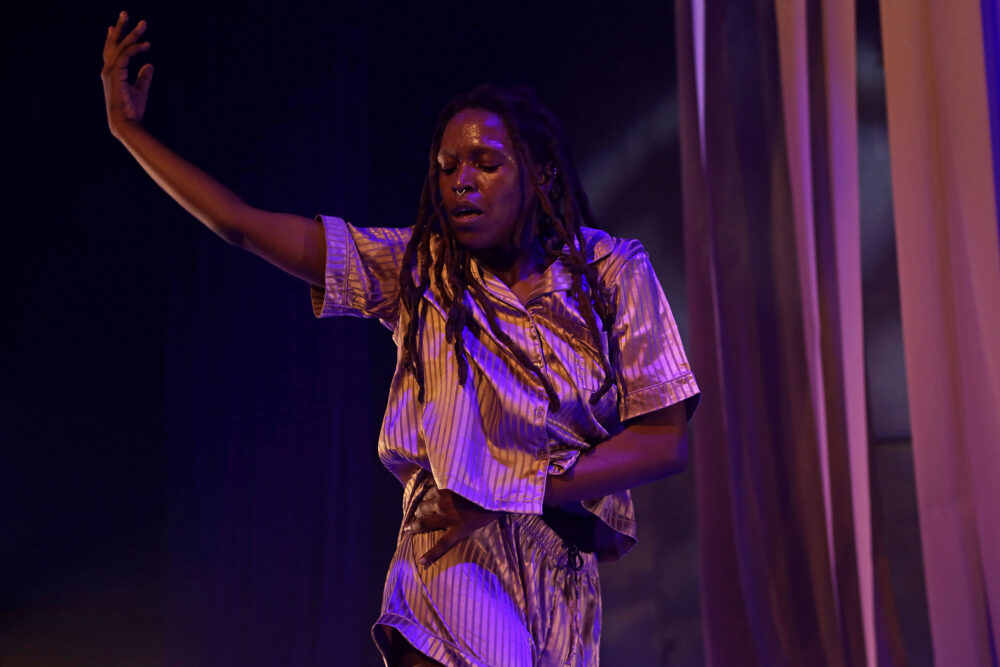Intense: Asanda Ruda performs Kemet at the National Arts Festival . Photos: Mark Wessels
For the duration of her performance, it was impossible to look away. Asanda Ruda, this year’s Standard Bank Young Artist for Dance, was performing not only as though her life depended on it, but seemed to be channelling some numinous force. In the theatre with us, there was something mystical, spiritual, divine.
Also on display? Her soul. Potent and alive.
It’s been said Ruda’s choreography “takes us to the crossroads of myth and motion”; she dances as the intersection of protest and lyricism, the poetry of her physical movements a match for the depth of her message.
She was, as she danced, expressing the unsayable, her repertoire of gestures and movements clues to her ability to communicate from a place beyond reason, her body calling out to the universe in plaintive cries, her performance a purging of the spirit.
It was thrilling, monumental, intimate and disquieting and it moved me in ways that are difficult to describe without lapsing further into hyperbole or becoming wholly esoteric.
The piece, a solo work that earlier this year earned Ruda a choreographer’s research residency award from the Centre National de la Danse and the Cité Internationale des Arts in Paris, is called Kemet (Black Lands). It’s an exhausting piece of structured improvisation that’s constantly in progress, shaped by Ruda’s ongoing personal reflection. It’s also an outward expression of a journey of self-emancipation.
It is “a protest of the self”, says Ruda, a movement towards “new states of being”. And while it is grounded in inherited dance traditions, it is also a ritual of escape from any “pre-defined framework of cultural inheritance”.
It is a dance of liberation and healing, a reckoning with the limitations of time, space and “transgenerational identity”, although any such cerebral or philosophical concerns tend not to intrude on the pleasure to be had from watching her dance. Witnessing Kemet is to connect viscerally with this world-class dancer-choreographer’s deepest emotions.
Kemet begins with Ruda emerging through a forest of hanging fabric, the music, deeply resonant chanting. It feels primal, prehistoric and mysterious, and yet seems to project into the future with its clean, wabi-sabi aesthetic, the crispness of the space, the intense focus of the dancer.
At times there were gestures so intimate and personal they startled me, and in other moments, her movements seemed like purges, emetic convulsions, the expulsion of bile, the release of pain or suffering. It was the spilling of guts in a metaphoric sense; visually it evoked emotional pain so intense it seemed physical.



 Photos: Mark Wessels
Photos: Mark Wessels
At various points, Ruda’s jaw opened wide to produce a voiceless, primal scream, a silent cry in which some urgent pain could be felt.
A featured prop was a grass mat that became all sorts of things shaped in the audience’s imagination: a sniper’s gun, heralding some terrible violence, war or assassination.
Kemet was the first half Ruda’s double bill at the Rhodes Box in Makhanda during the recent National Arts Festival. It was the first time she had performed in South Africa since before the pandemic; she has been living and working in Europe, where she danced in a touring production of The Rites of Spring with the Pina Bausch Foundation, an esteemed German dance company.
As much as she has had to situate herself — professionally — in Europe to achieve recognition, she is intensely committed to “African dance”. “I am — ridiculously — an African dancer,” she says, “although today I’m also a contemporary dancer who performs in the theatre.”
Even within the performance context, though, dancing is a spiritual act: “Every African expression of dance is a spiritual form. I could have done ballet if there’d been an opportunity but that was not interesting to my soul or to my spirit.”
By contrast, “African dance is dancing that requires the soul,” she says. “I believe African dance in itself is a ritual of healing, whether it’s Zulu dance or any other traditional form.”
Ruda says her work is grounded in dance as a form of spiritual healing.
“What is contemporary dance? It’s movement, stretching, pointing, blocking, jumping, blah, blah, blah … Anybody can open their arms and stretch and do it beautifully. But it is something different if you go deep within yourself and digest all those processes that make you who you are in order to create those movements. That is the difference.”
Now 32, Ruda has been dancing since she was a girl. While she recognises part of the pull of dance was the need to focus her energies, take her mind off the conditions associated with growing up poor in Soweto, she also saw dancing as a place of retreat, a safe haven where she could both hide and expand — and grow emotionally.
She believes she was guided by the spirit, that her soul itself sought out dance as a refuge, to feel protected and to be complete.
Her childhood schooling in African traditional dance led her to Moving into Dance, Sylvia Glasser’s facility in Johannesburg, known for having trained some of the country’s most respected choreographers
While her training has included Zulu dancing, pantsula and Afrofusion, Ruda’s not for fitting into boxes. She’s able to hold all this technical knowledge in her body and still create something that defies categorisation, that embodies originality.
It is work that “challenges the form and the norm,” says veteran dancer Musa Hlatshwayo in response to Kemet. “It will either soothe you or trigger you to have that internal conversation with your demons.”
For Ruda, on the other side of that conversation, dance is a daily ritual. It sustains her, keeps her safe, protects her, provides her with the armour she needs to face the world.
When asked about the choreographic process of constructing a work that is both a ritual and improvised, she says it invariably requires space and time in which to play.
“We don’t want to be chanting and doing rituals all day long,” she explains. “That would be like getting high the whole day.”
Instead, the typical rehearsal regimen involves creating a structure in which to play and explore, so when the dance ritual is being enacted, she is able to “remain calm and stay in control of the experience”.
Getting to that point, however, means “you need to allow yourself to be open and to play”.
While each rehearsal and every performance “is structured and guided by the same rules”, it is never repeated in precisely the same way. With each performance, “I pick a question that I want to ask.”
“The question is often around whatever it is that requires healing. If there is work to be done, the process of playing will reveal the ritual required. And so the movements are defined by the question that’s asked.”
Kemet is, in other words, a reckoning with forces beyond rational explanation. It is, Ruda says, also a ritual of preparation, of steeling — or “tooling” — herself, putting on a spiritual armour required to face the obstacles and frustrations in daily life.
Those frustrations are induced “by people, by politics, by whatever”. “But every day you need to heal and you need to tool yourself in preparation,” she says.
She admits that Kemet is “disturbing”, unavoidably so. “It is saying all the disturbing things that I want to say and that I need to tell you. It’s something very personal — my experience, the dreams that I have, the thoughts that I have with myself.”
As much as the work is an incredibly intimate “ritual of self”, it ultimately evolves into a study in empathy, a moving meditation that channels the feelings and emotions of other people whose pain is unknowable. To achieve this, the last part of Kemet is danced to music inspired by the conflict between Israel and Palestine. Ruda says she was prompted by her own frustrations around trying to parse the suffering of people caught up in that war.
“I thought to myself, I’m sitting here — free, emancipated — while there are other people who are fighting, people in a war,” she explained. “So, in this work, I’m trying to digest how another person — someone who is suffering — is feeling in that moment. I’m trying to be where they are, understand exactly what they are experiencing.”
In these moments when she enters spaces outside of her own reality, she borrows. “Sometimes these are not my own feelings or my own thoughts. But I go into those spaces, I travel outside of myself. I say, ‘Lend me your thoughts! Lend me your spirit!’ And I try to understand how it feels to be in your situation.”
Asanda Ruda will perform Kemet (Black Lands) and present a second, newer work at the Jomba! dance festival in Durban next month.